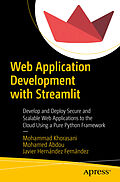

Web Application Development with Streamlit
Beschreibung
Transition from a back-end developer to a full-stack developer with knowledge of all the dimensions of web application development, namely, front-end, back-end and server-side software. This book provides a comprehensive overview of Streamlit, allowing develo...Format auswählen
- Kartonierter EinbandCHF 72.00
- Kartonierter EinbandCHF 98.55
Wird oft zusammen gekauft
Andere Kunden kauften auch
Beschreibung
Transition from a back-end developer to a full-stack developer with knowledge of all the dimensions of web application development, namely, front-end, back-end and server-side software. This book provides a comprehensive overview of Streamlit, allowing developers and programmers of all backgrounds to get up to speed in as little time as possible.
Streamlit is a pure Python web framework that will bridge the skills gap and shorten development time from weeks to hours. This book walks you through the complete cycle of web application development, from an introductory to advanced level with accompanying source code and resources. You will be exposed to developing basic, intermediate, and sophisticated user interfaces and subsequently you will be acquainted with data visualization, database systems, application security, and cloud deployment in Streamlit.
In a market with a surplus demand for full stack developers, this skill set could not possibly come at a better time. In one sentence, Streamlit is a means for the empowerment of developers everywhere and all stand to gain from it.
What You'll Learn
- Mutate big data in real-time
- Visualize big data interactively
- Implement web application security and privacy protocols
Deploy Streamlit web applications to the cloud using Streamlit, Linux and Windows servers
Who is this Book for?Developers with solid programming experience wanting to learn Streamlit; Back-end developers looking to upskill and transition to become a full-stack developers; Those who wish to learn and become more acquainted with data visualization, database systems, security and cloud deployment with Steamlit
Introduces Streamlit, the first pure Python framework for web development Provides a practical zero-to-hero guide to allow developers of all backgrounds get up to speed with Streamlit Empowers developers to upskill and transition to become full stack developers
Autorentext
Mohammad Khorasani A hybrid of an engineer and a computer scientist with a Bachelor's of Science in Mechanical Engineering from Texas A&M University, and a Master's in Computer Science from the University of Illinois at Urbana-Champaign. Mohammad specializes in developing and implementing software solutions for the advancement of renewable energy systems and services at Iberdrola. In addition, he develops robotic devices using embedded systems and rapid prototyping technologies. He is also an avid blog-ger of STEM related topics on Towards Data Science - a Medium publication.
Mohamed Abdou A Software Engineer with diverse academic and industrial exposure. A graduate of Computer Engineering from Qatar University, and currently a SDE at Amazon. Mohamed has built a variety of open source tools used by tens of thousands in the Streamlit community. He led the first Google Developer Student Club in Qatar, and represented Qatar University in national and international programming contests. He is a a cyber security enthusiast, and was ranked 2nd nationwide in bug bounty hunting in Qatar in 2020 among under 25 year old's.
Javier Hernandez Fernandez specializes in the area of technology innovation and brings over twenty years of practical experience in overseeing the design and delivery of technological developments on behalf of multi-national companies in the fields of IT, telecom, and utilities. He publishes extensively, speaks at conferences around the world, and spends his days wading through piles of academic papers in the hope of finding something interesting. He holds Masters' degrees in both Energy Management and Project Management, in addition to a B.Sc. in Computer Science from the from the Faculty of Engineering of the University of Ottawa.
Inhalt
Part I: Introduction to Streamlit
1 Getting Started with Streamlit
1.1 Why Streamlit?
1.2 How Streamlit Works
1.3 Firing it up
2 Streamlit Basics
2.1 The Streamlit API
2.2 Creating a basic app
Part II: Developing Advanced Interfaces and Applications
3 Architecting Streamlit's Front-end Design
3.1 Designing the application 3.2 Provisioning multi-page applications
3.3 Data wrangling
4 Graphing in Depth
4.1 Visualization stack
4.2 Exploring Plotly data visualizations
Part III: Interfacing with Database and Back-end Systems
5 Database Integration
5.1 Relational Databases
5.2 Non-relational databases
6 Back-end Servers
6.1 The need for back-end servers
6.2 Front-end/ Back-end Communication 6.3 Working with JSON files
6.4 Provisioning a back-end server
6.5 Multi-threading and multi-processing request
6.6 Connecting Streamlit to a Back-end Server
Part IV: Enforcing Application Security and Privacy
7 Session State
7.1 Introducing session IDs
7.2 Implementing session state persistently
7.3 Recording user insights
7.4 Implementing session state natively
7.5 Cookies management
8 Authentication and Application Security 8.1 Developing user accounts
8.2 Verifying user credentials
8.3 Secrets management
8.4 Anti-SQL injection measures with SQL Alchemy
8.5 Configuring Git Ignore variables
Part V: Deploying Streamlit to the Cloud
9 Persistent Deployment
9.1 Deployment to Streamlit Sharing
9.2 Deployment to Linux
9.3 Deployment to Windows Server
10 Exposing Local Streamlit to the World Wide Web
10.1 Port forwarding over network gateway
10.2 Reverse Port Forwarding using NGROK
Part VI: Streamlit Custom Components
11 Building Streamlit components with React.js
11.1 Introduction to Streamlit custom components
11.2 Using React.js to create custom HTML components
11.3 Deploying components as a Pip package
12 Extra-Streamlit-Components Package
12.1 Stepper bar
12.2 Splash screen . .
12.3 Tab bar
12.4 Cookie Manager
Part VII: Streamlit Case Studies
13 General Use Cases
13.1 Data science & machine learning applications
13.2 Dashboards and real-time applications
13.3 Time-series applications
13.4 Advanced application development
14 Steamlit at Work
14.1 Iberdrola Renewables
14.2 DummyLearn.com
